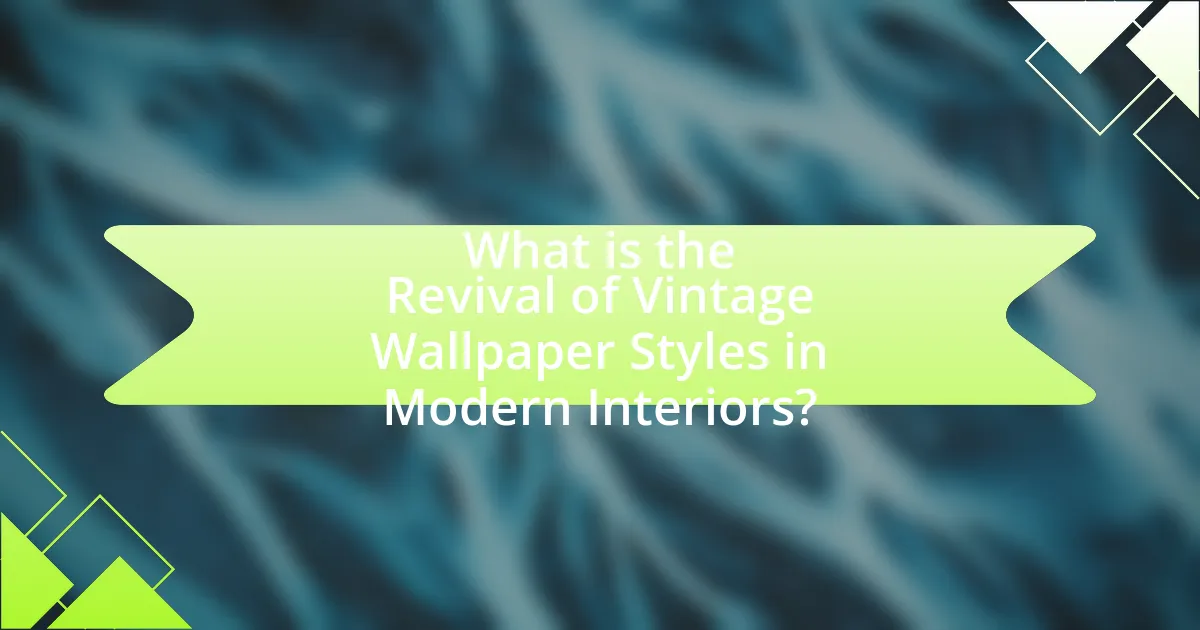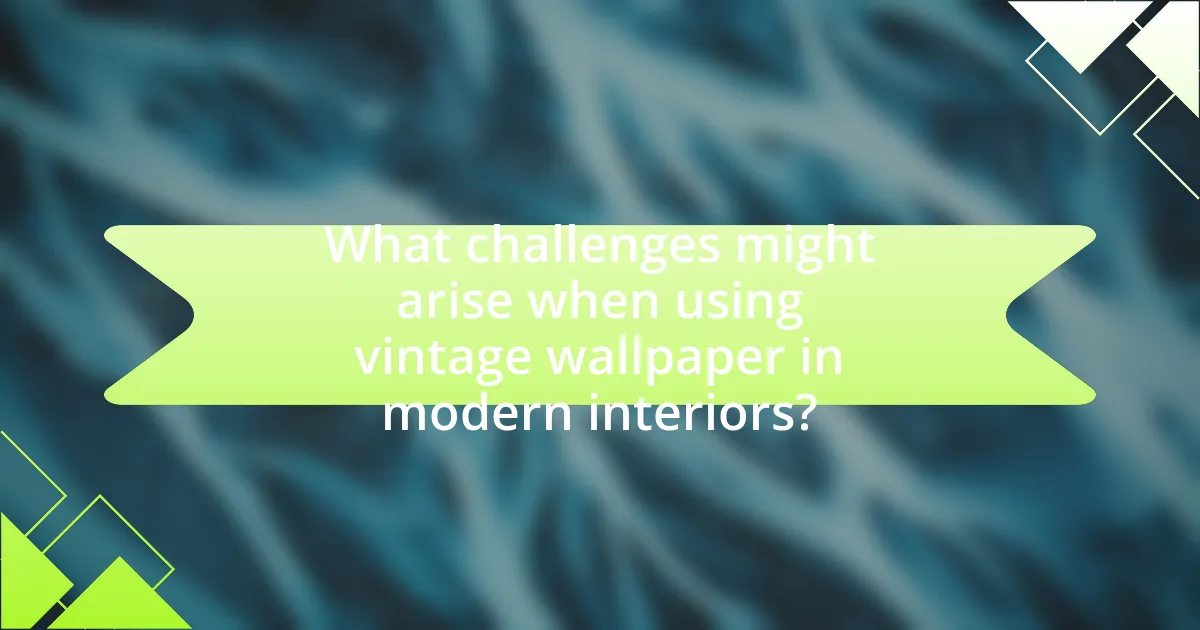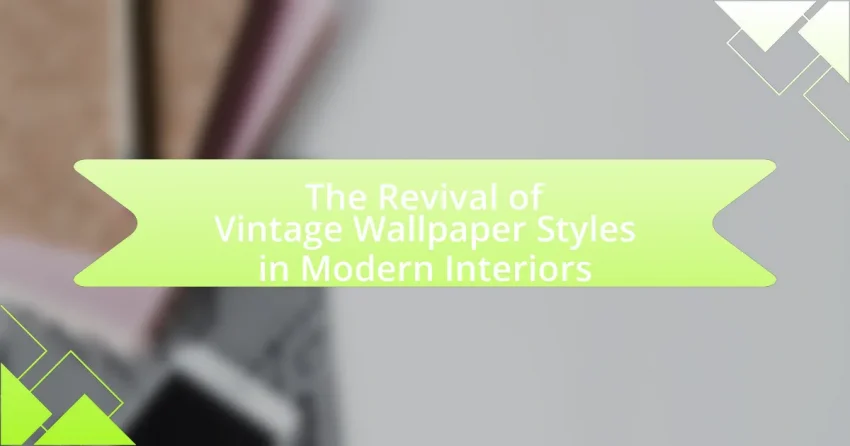The article examines the revival of vintage wallpaper styles in modern interiors, highlighting the renewed interest in classic designs characterized by bold patterns, intricate textures, and nostalgic motifs. It explores how this trend has emerged as a response to the desire for individuality and nostalgia in home decor, supported by advancements in printing technology and a focus on sustainability. Key historical influences, such as the Arts and Crafts movement and mid-20th century aesthetics, are discussed, along with the differences between modern interpretations and traditional styles. The article also addresses the aesthetic appeal, sustainability benefits, and practical considerations for integrating vintage wallpaper into contemporary spaces, including sourcing challenges and maintenance tips.

What is the Revival of Vintage Wallpaper Styles in Modern Interiors?
The revival of vintage wallpaper styles in modern interiors refers to the renewed interest and incorporation of classic wallpaper designs from past decades into contemporary home decor. This trend is characterized by the use of bold patterns, intricate textures, and nostalgic motifs that evoke a sense of history and charm. According to a 2021 report by the National Association of Home Builders, vintage wallpaper styles have gained popularity due to their ability to add character and warmth to spaces, with many homeowners seeking unique and personalized design elements. This resurgence is also supported by advancements in printing technology, allowing for high-quality reproductions of vintage designs that are both durable and easy to apply.
How has the trend of vintage wallpaper styles emerged in contemporary design?
The trend of vintage wallpaper styles has emerged in contemporary design as a response to the desire for nostalgia and individuality in interior spaces. Designers and homeowners increasingly seek to create unique atmospheres that reflect personal history and character, leading to a resurgence of patterns and textures reminiscent of past decades. This revival is supported by the availability of modern printing technologies that allow for the reproduction of intricate vintage designs, making them accessible and affordable. Additionally, the growing interest in sustainable and eco-friendly materials has prompted manufacturers to produce wallpapers that combine vintage aesthetics with contemporary sustainability practices, further solidifying the trend’s relevance in today’s design landscape.
What historical influences have shaped the revival of vintage wallpaper?
The revival of vintage wallpaper has been shaped by several historical influences, particularly the nostalgia for past design movements and the resurgence of interest in artisanal craftsmanship. The Arts and Crafts movement of the late 19th century emphasized handmade quality and natural motifs, which has inspired contemporary designers to seek out vintage patterns that reflect these values. Additionally, the mid-20th century’s bold graphic designs and vibrant colors have seen a resurgence as modern consumers seek to create unique and personalized spaces. The popularity of retro aesthetics in the 21st century, fueled by social media and home renovation shows, has further propelled the demand for vintage wallpaper, as it allows individuals to connect with historical styles while expressing their personal taste.
How do modern interpretations differ from traditional vintage styles?
Modern interpretations of vintage styles prioritize minimalism and functionality, contrasting with the ornate and intricate designs typical of traditional vintage styles. For instance, contemporary wallpaper often features simplified patterns and a more subdued color palette, reflecting current design trends that favor clean lines and open spaces. In contrast, traditional vintage wallpaper is characterized by elaborate motifs and vibrant colors, often inspired by historical art movements. This shift towards modern interpretations is supported by a growing preference for sustainable materials and eco-friendly production methods, which are less emphasized in traditional vintage styles.
Why are vintage wallpaper styles gaining popularity in modern interiors?
Vintage wallpaper styles are gaining popularity in modern interiors due to their unique aesthetic appeal and ability to evoke nostalgia. Homeowners and designers are increasingly drawn to the intricate patterns and textures that vintage wallpapers offer, which can add character and warmth to contemporary spaces. According to a 2022 survey by the National Association of Home Builders, 65% of interior designers reported a rise in demand for vintage and retro design elements, indicating a clear trend towards incorporating historical styles into modern decor. This resurgence is also fueled by a growing interest in sustainable design, as many vintage wallpapers are made from eco-friendly materials and promote the reuse of existing resources.
What aesthetic appeal do vintage wallpapers bring to contemporary spaces?
Vintage wallpapers bring a unique aesthetic appeal to contemporary spaces by infusing them with character, nostalgia, and a sense of history. This appeal stems from the intricate patterns and rich textures that vintage wallpapers often feature, which contrast with the minimalism commonly found in modern design. For instance, designs from the mid-20th century often showcase bold colors and geometric shapes that can serve as focal points in a room, enhancing visual interest. Additionally, the use of vintage wallpapers can evoke a sense of warmth and comfort, creating an inviting atmosphere that resonates with personal stories and memories. The revival of these styles reflects a growing trend towards individuality in interior design, where homeowners seek to express their unique tastes through curated elements that tell a story.
How do vintage wallpapers contribute to sustainability in interior design?
Vintage wallpapers contribute to sustainability in interior design by promoting the reuse of materials and reducing waste. These wallpapers often come from previous decades, allowing designers to incorporate unique, high-quality patterns without the environmental impact associated with manufacturing new materials. For instance, using vintage wallpapers can significantly lower the carbon footprint, as they do not require the energy-intensive processes involved in producing new wallpaper. Additionally, vintage wallpapers are typically made from more durable materials, which can lead to longer-lasting designs and less frequent replacements, further enhancing sustainability in interior spaces.

What are the key characteristics of vintage wallpaper styles?
Vintage wallpaper styles are characterized by intricate patterns, bold colors, and a nostalgic aesthetic that reflects design trends from past decades, particularly the 18th to mid-20th centuries. These wallpapers often feature floral motifs, damask patterns, and geometric designs, which were popular during their respective eras. The use of materials such as paper, vinyl, and fabric, along with techniques like block printing and screen printing, further defines their unique appearance. Historical context shows that vintage wallpaper was a significant aspect of interior design, with styles evolving through periods such as Art Deco, Victorian, and Mid-Century Modern, each contributing distinct visual elements that continue to influence contemporary decor.
What types of patterns and designs are commonly found in vintage wallpapers?
Common patterns and designs found in vintage wallpapers include floral motifs, damask patterns, geometric shapes, and toile designs. Floral motifs often feature large, bold flowers and intricate vines, reflecting the naturalistic styles popular in the 19th and early 20th centuries. Damask patterns are characterized by their ornate, symmetrical designs, typically in a monochromatic color scheme, which were prevalent during the Baroque and Rococo periods. Geometric shapes, including chevrons and stripes, gained popularity in the mid-20th century, showcasing a modernist aesthetic. Toile designs depict pastoral scenes and landscapes, often in a single color against a contrasting background, and were widely used in French decor. These patterns not only represent historical design trends but also influence contemporary interior design, as they are frequently revived in modern applications.
How do color palettes in vintage wallpapers differ from modern options?
Color palettes in vintage wallpapers typically feature muted, earthy tones and intricate patterns, while modern options often emphasize bold, vibrant colors and minimalistic designs. Vintage wallpapers, popular from the late 19th to mid-20th century, utilized natural dyes and pigments, resulting in softer hues like faded pastels and deep jewel tones that evoke nostalgia. In contrast, modern wallpapers leverage synthetic dyes, allowing for a wider range of bright and saturated colors, reflecting contemporary design trends that favor simplicity and stark contrasts. This shift in color palette reflects broader changes in aesthetic preferences and technological advancements in wallpaper production.
What textures and materials are typically used in vintage wallpaper production?
Vintage wallpaper production typically utilizes materials such as paper, vinyl, and fabric, along with textures like embossed, flocked, and textured finishes. Historically, paper was the primary material used, often featuring intricate designs and patterns that reflect the artistic styles of the era. Vinyl became popular in the mid-20th century due to its durability and ease of cleaning, while fabric wallpapers, such as silk or linen, were favored for their luxurious appearance. Textures like embossing create a three-dimensional effect, enhancing the visual appeal, while flocking adds a soft, velvety touch. These materials and textures contribute to the distinctive charm and character of vintage wallpapers, making them sought after in modern interior design.
How can vintage wallpaper styles be integrated into modern interiors?
Vintage wallpaper styles can be integrated into modern interiors by using them as accent walls or in smaller spaces to create focal points. This approach allows the intricate patterns and textures of vintage wallpaper to stand out without overwhelming the contemporary design. For instance, a bold floral or geometric vintage wallpaper can complement minimalist furniture and modern color palettes, creating a balanced aesthetic. Additionally, incorporating vintage wallpaper in areas like powder rooms or hallways can add character and charm, enhancing the overall ambiance of the space. Historical trends show that the resurgence of vintage styles in interior design has been driven by a desire for personalization and uniqueness, making this integration not only visually appealing but also culturally relevant.
What are the best practices for selecting vintage wallpaper for a space?
The best practices for selecting vintage wallpaper for a space include assessing the room’s overall style, considering the color palette, and evaluating the wallpaper’s condition. First, aligning the wallpaper with the existing decor ensures a cohesive aesthetic; for example, a floral pattern may complement a vintage or rustic theme. Second, selecting colors that harmonize with the room’s furnishings enhances visual appeal; muted tones can create a calming atmosphere, while bold colors can serve as a focal point. Lastly, inspecting the wallpaper for damage or fading is crucial, as high-quality vintage wallpaper should be intact and vibrant to maintain its charm. These practices are supported by interior design principles that emphasize harmony, color theory, and the importance of quality in vintage materials.
How can vintage wallpaper be paired with modern furnishings effectively?
Vintage wallpaper can be paired with modern furnishings effectively by selecting complementary color palettes and patterns that enhance the overall aesthetic. For instance, a bold floral vintage wallpaper can be balanced with sleek, minimalist furniture in neutral tones, allowing the wallpaper to serve as a focal point without overwhelming the space. Additionally, incorporating modern accessories, such as geometric light fixtures or contemporary art, can create a harmonious blend of styles. This approach is supported by design principles that emphasize contrast and balance, ensuring that the vintage elements do not clash with modern designs but instead create a cohesive look.

What challenges might arise when using vintage wallpaper in modern interiors?
Using vintage wallpaper in modern interiors can present several challenges, including compatibility with contemporary design elements, potential damage to the wallpaper, and issues related to sourcing and installation. Compatibility issues arise because vintage patterns and colors may clash with modern aesthetics, making it difficult to create a cohesive look. Additionally, vintage wallpaper may be fragile or deteriorated, leading to difficulties in installation and maintenance. Sourcing authentic vintage wallpaper can also be challenging, as it often requires extensive searching and may come at a premium price. These factors can complicate the integration of vintage wallpaper into modern spaces, necessitating careful consideration and planning.
What are the common issues related to sourcing vintage wallpaper?
Common issues related to sourcing vintage wallpaper include limited availability, condition concerns, and authenticity verification. Limited availability arises because vintage wallpaper is often discontinued, making it difficult to find specific patterns or quantities needed for projects. Condition concerns are prevalent, as older wallpaper may suffer from damage, discoloration, or deterioration, which can affect its usability. Authenticity verification is crucial, as the market may contain reproductions or misrepresented items, requiring buyers to have knowledge of historical design elements and printing techniques to ensure they are purchasing genuine vintage pieces.
How can one address the maintenance and durability concerns of vintage wallpapers?
To address the maintenance and durability concerns of vintage wallpapers, one should apply protective coatings and ensure proper installation techniques. Protective coatings, such as clear varnishes or sealants, can enhance the wallpaper’s resistance to moisture and fading, thereby prolonging its lifespan. Additionally, using acid-free adhesives during installation minimizes the risk of damage from chemical reactions over time. Historical data indicates that vintage wallpapers, when properly maintained, can last for decades, as evidenced by many well-preserved examples in heritage homes. Regular cleaning with a soft, dry cloth and avoiding harsh chemicals further supports the longevity of these materials.
What are some tips for successfully incorporating vintage wallpaper into your home?
To successfully incorporate vintage wallpaper into your home, choose a focal wall to create a striking visual impact. This approach allows the vintage design to stand out without overwhelming the space. Additionally, consider pairing vintage wallpaper with modern furnishings to create a balanced aesthetic; this contrast highlights the unique character of the wallpaper while maintaining a contemporary feel. It is also essential to ensure that the colors and patterns of the vintage wallpaper complement the existing decor, as harmonious integration enhances the overall design. Lastly, using vintage wallpaper in smaller areas, such as a powder room or an accent nook, can add charm without dominating the room. These strategies are supported by interior design principles that emphasize balance, contrast, and harmony in decor.
How can you create a cohesive design with vintage wallpaper in various rooms?
To create a cohesive design with vintage wallpaper in various rooms, select a unifying color palette or pattern that resonates across all spaces. This approach ensures that each room feels connected while allowing for individual character. For instance, if a floral vintage wallpaper features shades of blue and green, incorporate those colors in furnishings or accents throughout the home. Additionally, using similar styles of vintage wallpaper, such as damask or toile, can enhance the overall aesthetic. Historical design principles suggest that maintaining consistency in elements like color and pattern fosters harmony in interior spaces, making the design feel intentional and well-planned.
What resources are available for finding authentic vintage wallpaper styles?
Authentic vintage wallpaper styles can be found through specialized online marketplaces, antique shops, and dedicated vintage wallpaper retailers. Websites like Etsy and eBay offer a wide range of vintage wallpaper options from various sellers, ensuring authenticity through user reviews and seller ratings. Additionally, resources such as the Vintage Wallpaper Archive provide a curated collection of historical designs, while local antique shops often carry unique finds that reflect specific eras. These platforms not only showcase genuine vintage styles but also provide context and history, enhancing the authenticity of the selections available.
